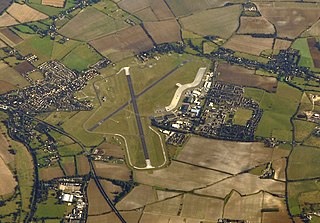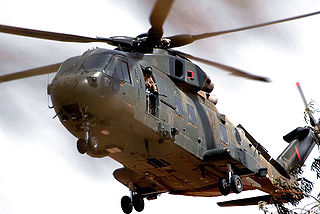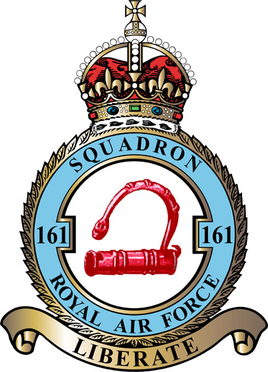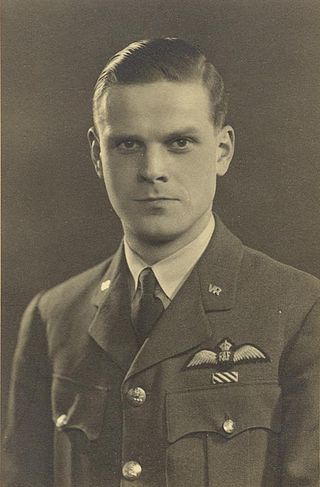
The Avro 679 Manchester was a British twin-engine heavy bomber developed and manufactured by the Avro aircraft company in the United Kingdom. While not being built in great numbers, it was the forerunner of the more famed and more successful four-engined Avro Lancaster, which was one of the most capable strategic bombers of the Second World War.

Royal Air Force Benson or RAF Benson is a Royal Air Force (RAF) station located at Benson, near Wallingford, in South Oxfordshire, England. It is a front-line station and home to the RAF's fleet of Westland Puma HC2 support helicopters, used primarily for the transportation of troops & equipment. Flying squadrons comprise No. 33 Squadron flying the Puma, No. 22 Squadron which provides operational evaluation and training for all aircraft in Joint Aviation Command and No. 28 Squadron, which is the combined Puma and Boeing Chinook HC6A training unit. Other units include the Oxford University Air Squadron and No. 6 Air Experience Flight, both flying the Grob Tutor T1 light training aircraft used for student and cadet flying training. The National Police Air Service and the Thames Valley Air Ambulance are also based at the station, both operating Airbus H135 helicopters.

The Armstrong Whitworth A.W.38 Whitley was a British heavy bomber aircraft of the 1930s. It was one of three twin-engined, front line medium bomber types that were in service with the Royal Air Force (RAF) at the outbreak of the Second World War. Alongside the Vickers Wellington and the Handley Page Hampden, the Whitley was developed during the mid-1930s according to Air Ministry Specification B.3/34, which it was subsequently selected to meet. In 1937, the Whitley formally entered into RAF squadron service; it was the first of the three medium bombers to be introduced.

Number 10 Squadron is a Royal Air Force squadron. The squadron has served in a variety of roles over its 90-year history. It currently flies the Airbus Voyager KC2/KC3 in the transport/tanker role from RAF Brize Norton, Oxfordshire.

The Boeing Chinook is a large, tandem rotor helicopter operated by the Royal Air Force (RAF). A series of variants based on the United States Army's Boeing CH-47 Chinook, the RAF Chinook fleet is the largest outside the United States. RAF Chinooks have seen extensive service in the Falklands War, the Balkans, Northern Ireland, Iraq, and Afghanistan.

No. 7 Squadron is a special operations support squadron of the Royal Air Force operates the Boeing Chinook HC6 from RAF Odiham, Hampshire.

Number 28 Squadron, also known as No. 28 Squadron or No. 28 (AC) Squadron, is a squadron of the Royal Air Force. Based at RAF Benson, it serves as the RAF's Operational Conversion Unit for the Westland Puma HC2 and Boeing Chinook HC5/6/6A helicopters.

No. 202 Squadron of the Royal Air Force is the maritime and mountains training element of the No.1 Flying Training School, operating the Airbus Helicopters H145 Jupiter.

Number 51 Squadron is a squadron of the Royal Air Force. Since 2014 it has operated the Boeing RC-135W Airseeker R.1, more commonly referred to as the Rivet Joint, from RAF Waddington, Lincolnshire.

No. 1419 Flight RAF was a flight within the Royal Air Force.

MOD Boscombe Down(ICAO: EGDM) is the home of a military aircraft testing site, on the south-eastern outskirts of the town of Amesbury, Wiltshire, England. The site is managed by QinetiQ, the private defence company created as part of the breakup of the Defence Evaluation and Research Agency (DERA) in 2001 by the UK Ministry of Defence (MoD).

No. 161 Squadron was a highly secretive unit of the Royal Air Force, performing missions as part of the Royal Air Force Special Duties Service. It was tasked with missions of the Special Operations Executive (SOE) and the Secret Intelligence Service (SIS) during the Second World War. Their primary role was to drop and collect secret agents and equipment into and from Nazi-occupied Europe. The squadron had a secondary role in acting as the King's Flight, where it was responsible for transporting royal family members.

No. 102 Squadron was a Royal Air Force night bomber squadron in the First World War and a heavy bomber squadron in the Second World War. After the war it flew briefly as a transport squadron before being reformed a light bomber unit with the Second Tactical Air Force within RAF Germany. Its last existence was as a Thor strategic missile unit.
No. 298 Squadron was a Royal Air Force special operations squadron during the Second World War. Later in that war it changed to the transport role, disbanding after the end of the hostilities.
No. 77 Squadron RAF was a squadron of the Royal Air Force which was active in various incarnations between 1916 and 1963.

No. 502 (Ulster) Squadron is a squadron of the Royal Auxiliary Air Force that was reformed in September 2013, and is the oldest active reserve squadron, having been formed in 1925. The squadron took park in anti-submarine patrols and bombing sorties in the Second World War.
No. 58 Squadron was a squadron of the Royal Air Force. For much of its service history in the First and Second World Wars, it operated as a bomber squadron. In the later stages of the Second World War, it was part of Coastal Command and was engaged in anti-submarine patrols.

No. 103 Squadron was a Royal Air Force bomber squadron during World War I, World War II and the Cold War, switching to helicopters in the late 1950s until it was disbanded for the last time in 1975.

Wing Commander Peter Stanley James, was a pilot in the Royal Air Force Volunteer Reserve during the Second World War, flying in RAF Bomber Command with No. 35 Squadron, No. 78 Squadron and No. 148 Squadron.



















